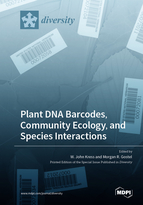Plant DNA Barcodes, Community Ecology, and Species Interactions
A special issue of Diversity (ISSN 1424-2818). This special issue belongs to the section "Phylogeny and Evolution".
Deadline for manuscript submissions: closed (30 January 2022) | Viewed by 47717
Special Issue Editors
Interests: biodiversity genomics; DNA barcoding; plant-animal interactions; conservation; The Anthropocene; Zingiberales
Special Issues, Collections and Topics in MDPI journals
Interests: biogeography; genomics; phylogenetics; systematics; taxonomy; Compositae; Burseraceae; conservation
Special Issue Information
Dear Colleagues,
The community of biologists has been eager to realize the promise of DNA barcodes since the concept was first proposed in 2003. As we approach twenty years of DNA barcoding, their application continues to increase and methods continue to be developed that utilize this ever-expanding resource for multiple fields of biology. The nearly ten million DNA barcodes available today provide a database that is especially useful for ecology and evolutionary biology. In particular, DNA barcodes provide a rapid resource to identify taxa; quantify and understand species richness; and determine community interactions in primary and secondary habitats. Many ecologists are concerned with the assembly and maintenance of species richness at local and regional scales, which has driven empirical and conceptual advances in the field of community ecology. Evolutionary biologists focus on the description and classification of species diversity, factors controlling the origin and ancestry of biodiversity, and the network of interactions that connect evolutionary units through time and space. Thanks to these large and well-curated DNA barcoding resources fundamental biological questions can be more rigorously addressed regarding community evolution, assembly, productivity, and species interactions across and among diverse habitats and organisms, including plants, animals, fungi, and microorganisms. DNA barcodes are now routinely used to discover new species, to determine phylogenetic patterns of community diversity, and to uncover the complexities of interactions in almost all domains of life to understand diets, symbioses, pollinator networks, and historically challenging biomes, such as below-ground soil and deep-water marine communities. This Special Issue will illustrate the wide variety of applications of DNA barcodes, especially in plants, to address questions in ecology and evolutionary biology.
Dr. W. John Kress
Dr. Morgan R. Gostel
Guest Editors
Manuscript Submission Information
Manuscripts should be submitted online at www.mdpi.com by registering and logging in to this website. Once you are registered, click here to go to the submission form. Manuscripts can be submitted until the deadline. All submissions that pass pre-check are peer-reviewed. Accepted papers will be published continuously in the journal (as soon as accepted) and will be listed together on the special issue website. Research articles, review articles as well as short communications are invited. For planned papers, a title and short abstract (about 100 words) can be sent to the Editorial Office for announcement on this website.
Submitted manuscripts should not have been published previously, nor be under consideration for publication elsewhere (except conference proceedings papers). All manuscripts are thoroughly refereed through a single-blind peer-review process. A guide for authors and other relevant information for submission of manuscripts is available on the Instructions for Authors page. Diversity is an international peer-reviewed open access monthly journal published by MDPI.
Please visit the Instructions for Authors page before submitting a manuscript. The Article Processing Charge (APC) for publication in this open access journal is 2600 CHF (Swiss Francs). Submitted papers should be well formatted and use good English. Authors may use MDPI's English editing service prior to publication or during author revisions.
Keywords
- DNA barcodes
- community ecology
- species interactions
- evolution
- species discovery
- pollination
- herbivory
- plants
- animals
- fungi
- microorganisms







